weight FIAT DOBLO COMBI 2009 Owner handbook (in English)
[x] Cancel search | Manufacturer: FIAT, Model Year: 2009, Model line: DOBLO COMBI, Model: FIAT DOBLO COMBI 2009Pages: 274, PDF Size: 6.16 MB
Page 245 of 274
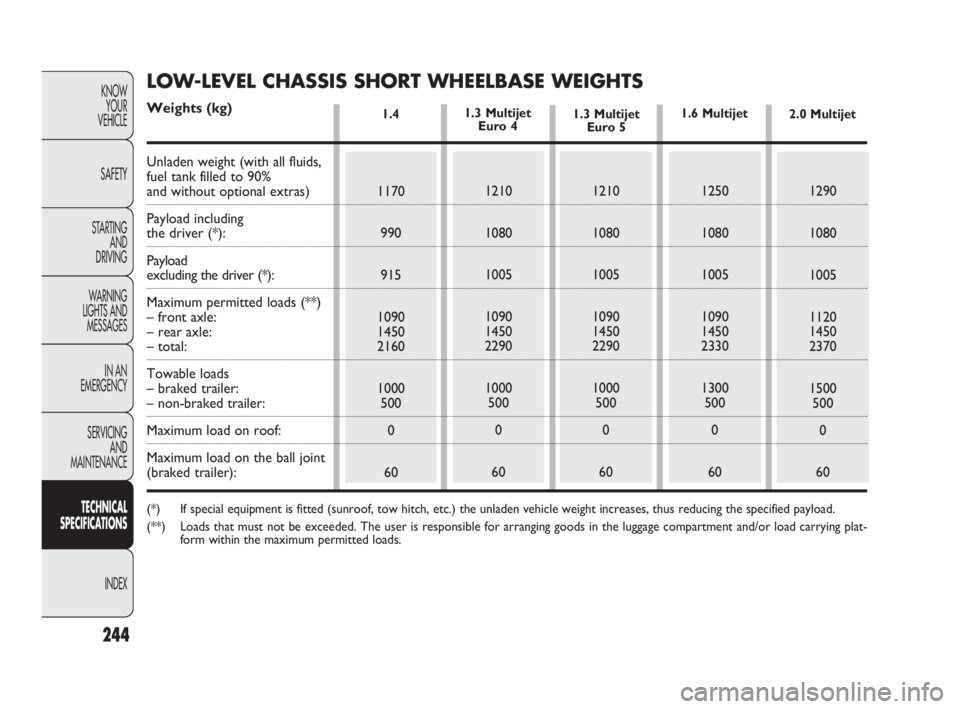
244
KNOW
YOUR
VEHICLE
SAFETY
STARTING
AND
DRIVING
WARNING
LIGHTS AND
MESSAGES
IN AN
EMERGENCY
SERVICING
AND
MAINTENANCE
TECHNICAL
SPECIFICATIONS
INDEX
1.4
1170
990
915
1090
1450
2160
1000
500
0
601210
1080
1005
1090
1450
2290
1000
500
0
601250
1080
1005
1090
1450
2330
1300
500
0
601210
1080
1005
1090
1450
2290
1000
500
0
60
1.3 Multijet
Euro 41.3 Multijet
Euro 5 1.6 Multijet2.0 Multijet
1290
1080
1005
1120
1450
2370
1500
500
0
60
LOW-LEVEL CHASSIS SHORT WHEELBASE WEIGHTS
Weights (kg)
Unladen weight (with all fluids,
fuel tank filled to 90%
and without optional extras)
Payload including
the driver (*):
Payload
excluding the driver (*):
Maximum permitted loads (**)
– front axle:
– rear axle:
– total:
Towable loads
– braked trailer:
– non-braked trailer:
Maximum load on roof:
Maximum load on the ball joint
(braked trailer):
(*) If special equipment is fitted (sunroof, tow hitch, etc.) the unladen vehicle weight increases, thus reducing the specified payload.
(**) Loads that must not be exceeded. The user is responsible for arranging goods in the luggage compartment and/or load carrying plat-
form within the maximum permitted loads.
219-260 DOBLO LUM EN 2e 7.0 27-05-2010 15:10 Pagina 244
Page 246 of 274
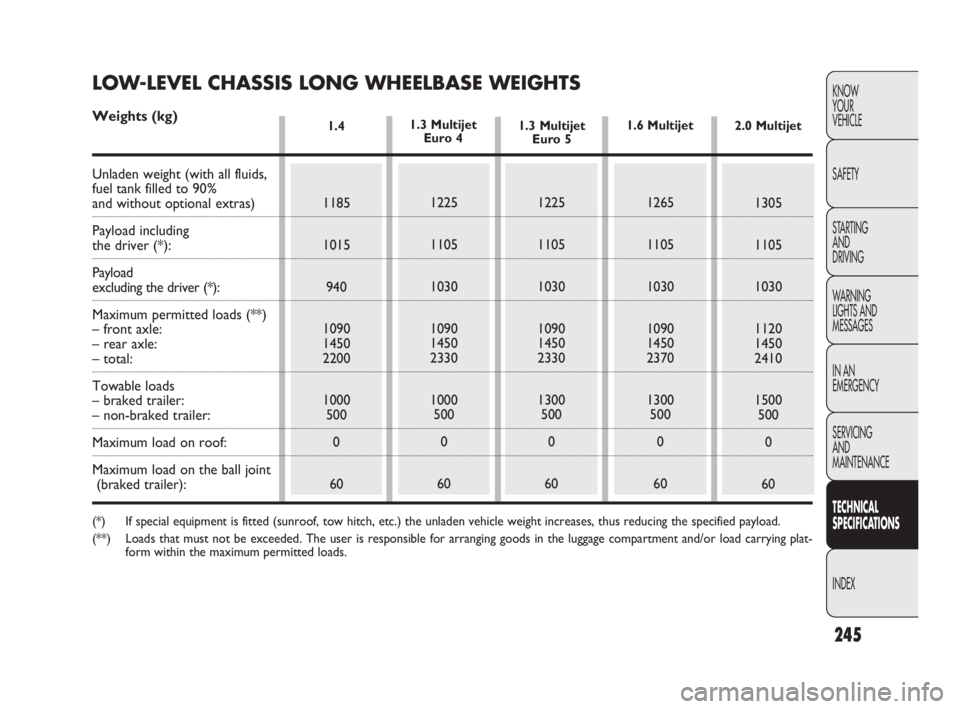
245
KNOW
YOUR
VEHICLE
SAFETY
STARTING
AND
DRIVING
WARNING
LIGHTS AND
MESSAGES
IN AN
EMERGENCY
SERVICING
AND
MAINTENANCE
TECHNICAL
SPECIFICATIONS
INDEX
1.4
1185
1015
940
1090
1450
2200
1000
500
0
601225
1105
1030
1090
1450
2330
1000
500
0
601265
1105
1030
1090
1450
2370
1300
500
0
601225
1105
1030
1090
1450
2330
1300
500
0
60
1.3 Multijet
Euro 41.3 Multijet
Euro 5 1.6 Multijet2.0 Multijet
1305
1105
1030
1120
1450
2410
1500
500
0
60
LOW-LEVEL CHASSIS LONG WHEELBASE WEIGHTS
Weights (kg)
Unladen weight (with all fluids,
fuel tank filled to 90%
and without optional extras)
Payload including
the driver (*):
Payload
excluding the driver (*):
Maximum permitted loads (**)
– front axle:
– rear axle:
– total:
Towable loads
– braked trailer:
– non-braked trailer:
Maximum load on roof:
Maximum load on the ball joint
(braked trailer):
(*) If special equipment is fitted (sunroof, tow hitch, etc.) the unladen vehicle weight increases, thus reducing the specified payload.
(**) Loads that must not be exceeded. The user is responsible for arranging goods in the luggage compartment and/or load carrying plat-
form within the maximum permitted loads.
219-260 DOBLO LUM EN 2e 7.0 27-05-2010 15:10 Pagina 245
Page 250 of 274
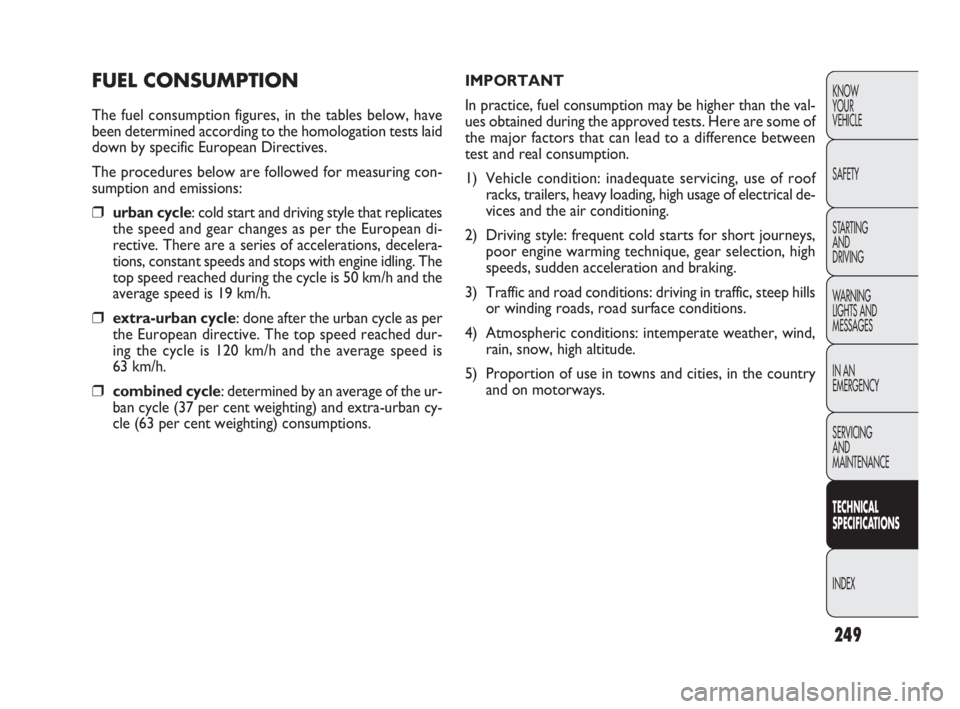
249
KNOW
YOUR
VEHICLE
SAFETY
STARTING
AND
DRIVING
WARNING
LIGHTS AND
MESSAGES
IN AN
EMERGENCY
SERVICING
AND
MAINTENANCE
TECHNICAL
SPECIFICATIONS
INDEX
FUEL CONSUMPTION
The fuel consumption figures, in the tables below, have
been determined according to the homologation tests laid
down by specific European Directives.
The procedures below are followed for measuring con-
sumption and emissions:
❒urban cycle: cold start and driving style that replicates
the speed and gear changes as per the European di-
rective. There are a series of accelerations, decelera-
tions, constant speeds and stops with engine idling. The
top speed reached during the cycle is 50 km/h and the
average speed is 19 km/h.
❒extra-urban cycle: done after the urban cycle as per
the European directive. The top speed reached dur-
ing the cycle is 120 km/h and the average speed is
63 km/h.
❒combined cycle: determined by an average of the ur-
ban cycle (37 per cent weighting) and extra-urban cy-
cle (63 per cent weighting) consumptions.IMPORTANT
In practice, fuel consumption may be higher than the val-
ues obtained during the approved tests. Here are some of
the major factors that can lead to a difference between
test and real consumption.
1) Vehicle condition: inadequate servicing, use of roof
racks, trailers, heavy loading, high usage of electrical de-
vices and the air conditioning.
2) Driving style: frequent cold starts for short journeys,
poor engine warming technique, gear selection, high
speeds, sudden acceleration and braking.
3) Traffic and road conditions: driving in traffic, steep hills
or winding roads, road surface conditions.
4) Atmospheric conditions: intemperate weather, wind,
rain, snow, high altitude.
5) Proportion of use in towns and cities, in the country
and on motorways.
219-260 DOBLO LUM EN 2e 7.0 27-05-2010 15:10 Pagina 249
Page 251 of 274
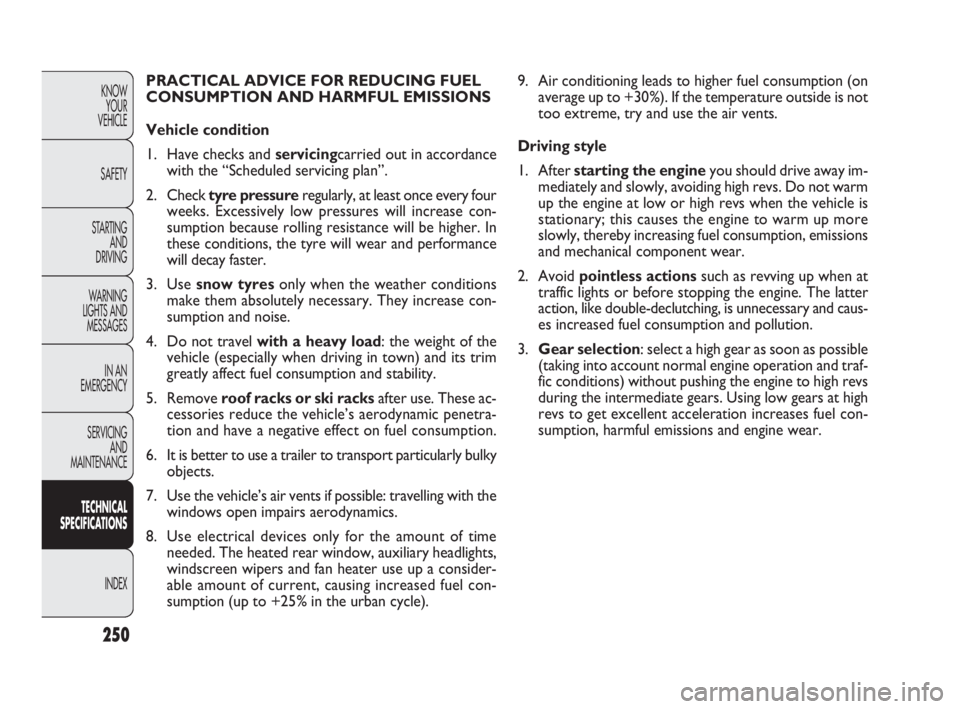
250
KNOW
YOUR
VEHICLE
SAFETY
STARTING
AND
DRIVING
WARNING
LIGHTS AND
MESSAGES
IN AN
EMERGENCY
SERVICING
AND
MAINTENANCE
TECHNICAL
SPECIFICATIONS
INDEX
9. Air conditioning leads to higher fuel consumption (on
average up to +30%). If the temperature outside is not
too extreme, try and use the air vents.
Driving style
1. After starting the engineyou should drive away im-
mediately and slowly, avoiding high revs. Do not warm
up the engine at low or high revs when the vehicle is
stationary; this causes the engine to warm up more
slowly, thereby increasing fuel consumption, emissions
and mechanical component wear.
2. Avoid pointless actions such as revving up when at
traffic lights or before stopping the engine. The latter
action, like double-declutching, is unnecessary and caus-
es increased fuel consumption and pollution.
3.Gear selection: select a high gear as soon as possible
(taking into account normal engine operation and traf-
fic conditions) without pushing the engine to high revs
during the intermediate gears. Using low gears at high
revs to get excellent acceleration increases fuel con-
sumption, harmful emissions and engine wear. PRACTICAL ADVICE FOR REDUCING FUEL
CONSUMPTION AND HARMFUL EMISSIONS
Vehicle condition
1. Have checks and servicingcarried out in accordance
with the “Scheduled servicing plan”.
2. Check tyre pressure regularly, at least once every four
weeks. Excessively low pressures will increase con-
sumption because rolling resistance will be higher. In
these conditions, the tyre will wear and performance
will decay faster.
3. Use snow tyresonly when the weather conditions
make them absolutely necessary. They increase con-
sumption and noise.
4. Do not travel with a heavy load: the weight of the
vehicle (especially when driving in town) and its trim
greatly affect fuel consumption and stability.
5. Remove roof racks or ski racksafter use. These ac-
cessories reduce the vehicle’s aerodynamic penetra-
tion and have a negative effect on fuel consumption.
6. It is better to use a trailer to transport particularly bulky
objects.
7. Use the vehicle’s air vents if possible: travelling with the
windows open impairs aerodynamics.
8. Use electrical devices only for the amount of time
needed. The heated rear window, auxiliary headlights,
windscreen wipers and fan heater use up a consider-
able amount of current, causing increased fuel con-
sumption (up to +25% in the urban cycle).
219-260 DOBLO LUM EN 2e 7.0 27-05-2010 15:10 Pagina 250
Page 256 of 274
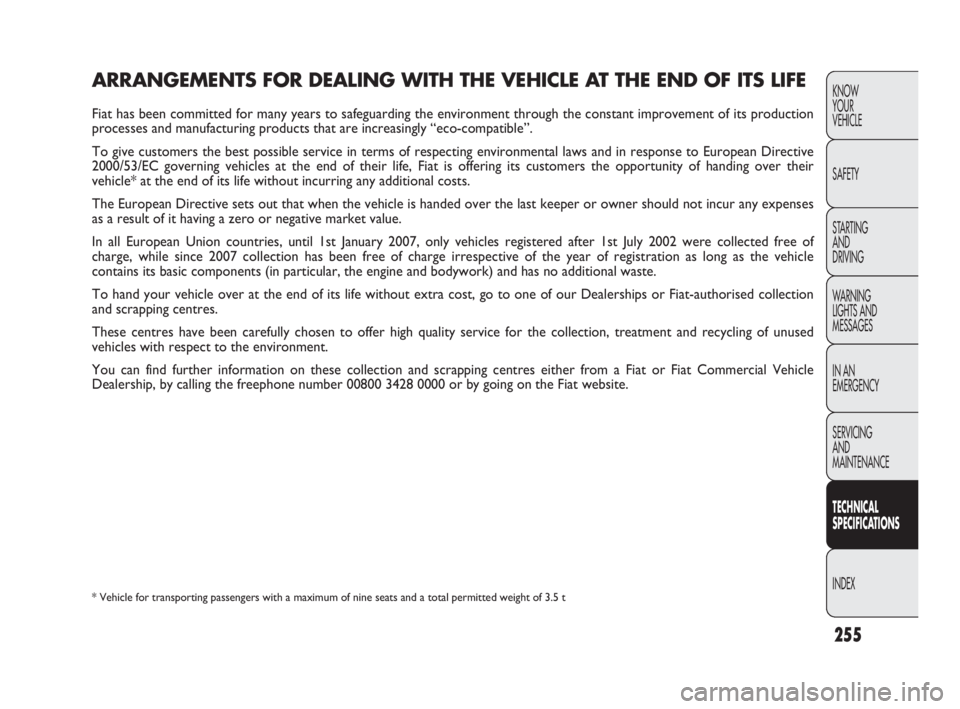
255
KNOW
YOUR
VEHICLE
SAFETY
STARTING
AND
DRIVING
WARNING
LIGHTS AND
MESSAGES
IN AN
EMERGENCY
SERVICING
AND
MAINTENANCE
TECHNICAL
SPECIFICATIONS
INDEX
ARRANGEMENTS FOR DEALING WITH THE VEHICLE AT THE END OF ITS LIFE
Fiat has been committed for many years to safeguarding the environment through the constant improvement of its production
processes and manufacturing products that are increasingly “eco-compatible”.
To give customers the best possible service in terms of respecting environmental laws and in response to European Directive
2000/53/EC governing vehicles at the end of their life, Fiat is offering its customers the opportunity of handing over their
vehicle* at the end of its life without incurring any additional costs.
The European Directive sets out that when the vehicle is handed over the last keeper or owner should not incur any expenses
as a result of it having a zero or negative market value.
In all European Union countries, until 1st January 2007, only vehicles registered after 1st July 2002 were collected free of
charge, while since 2007 collection has been free of charge irrespective of the year of registration as long as the vehicle
contains its basic components (in particular, the engine and bodywork) and has no additional waste.
To hand your vehicle over at the end of its life without extra cost, go to one of our Dealerships or Fiat-authorised collection
and scrapping centres.
These centres have been carefully chosen to offer high quality service for the collection, treatment and recycling of unused
vehicles with respect to the environment.
You can find further information on these collection and scrapping centres either from a Fiat or Fiat Commercial Vehicle
Dealership, by calling the freephone number 00800 3428 0000 or by going on the Fiat website.
* Vehicle for transporting passengers with a maximum of nine seats and a total permitted weight of 3.5 t
219-260 DOBLO LUM EN 2e 7.0 27-05-2010 15:10 Pagina 255
Page 272 of 274
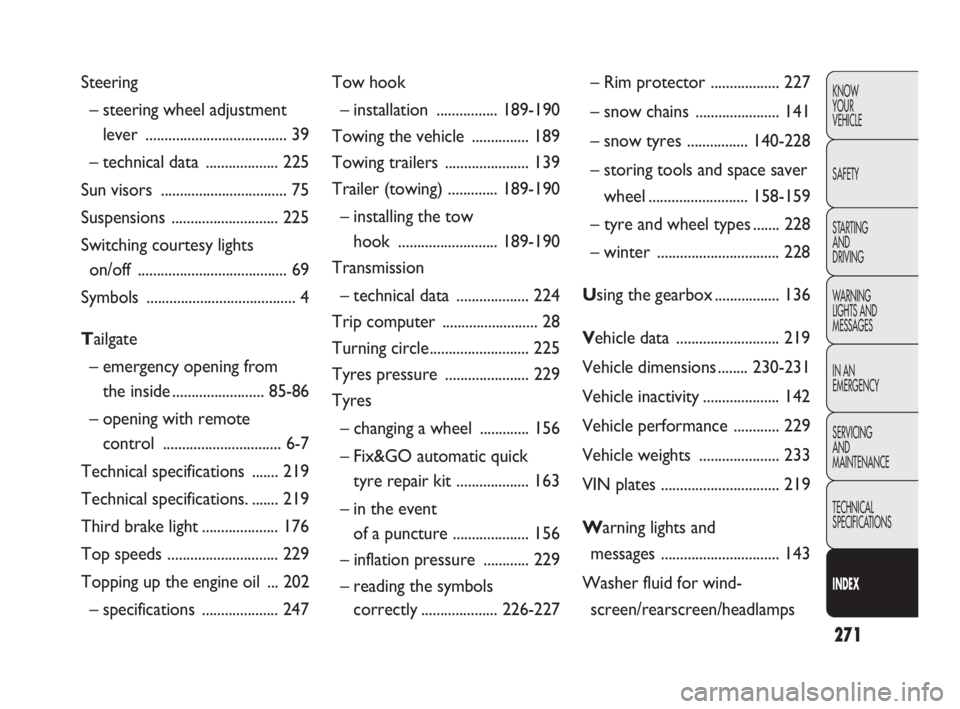
271
KNOW
YOUR
VEHICLE
SAFETY
STARTING
AND
DRIVING
WARNING
LIGHTS AND
MESSAGES
IN AN
EMERGENCY
SERVICING
AND
MAINTENANCE
TECHNICAL
SPECIFICATIONS
INDEX
Steering
– steering wheel adjustment
lever ..................................... 39
– technical data ................... 225
Sun visors ................................. 75
Suspensions ............................ 225
Switching courtesy lights
on/off ....................................... 69
Symbols ....................................... 4
Tailgate
– emergency opening from
the inside........................85-86
– opening with remote
control ............................... 6-7
Technical specifications ....... 219
Technical specifications. ....... 219
Third brake light.................... 176
Top speeds ............................. 229
Topping up the engine oil ... 202
– specifications .................... 247Tow hook
– installation ................189-190
Towing the vehicle ............... 189
Towing trailers ...................... 139
Trailer (towing) .............189-190
– installing the tow
hook ..........................189-190
Transmission
– technical data ................... 224
Trip computer ......................... 28
Turning circle.......................... 225
Tyres pressure ...................... 229
Tyres
– changing a wheel ............. 156
– Fix&GO automatic quick
tyre repair kit ................... 163
– in the event
of a puncture .................... 156
– inflation pressure ............ 229
– reading the symbols
correctly....................226-227– Rim protector .................. 227
– snow chains ...................... 141
– snow tyres ................140-228
– storing tools and space saver
wheel..........................158-159
– tyre and wheel types ....... 228
– winter ................................ 228
Using the gearbox ................. 136
Vehicle data ........................... 219
Vehicle dimensions ........ 230-231
Vehicle inactivity.................... 142
Vehicle performance ............ 229
Vehicle weights ..................... 233
VIN plates ............................... 219
Warning lights and
messages ............................... 143
Washer fluid for wind-
screen/rearscreen/headlamps
261-272 DOBLO LUM EN 2e 7.0 24-05-2010 9:26 Pagina 271